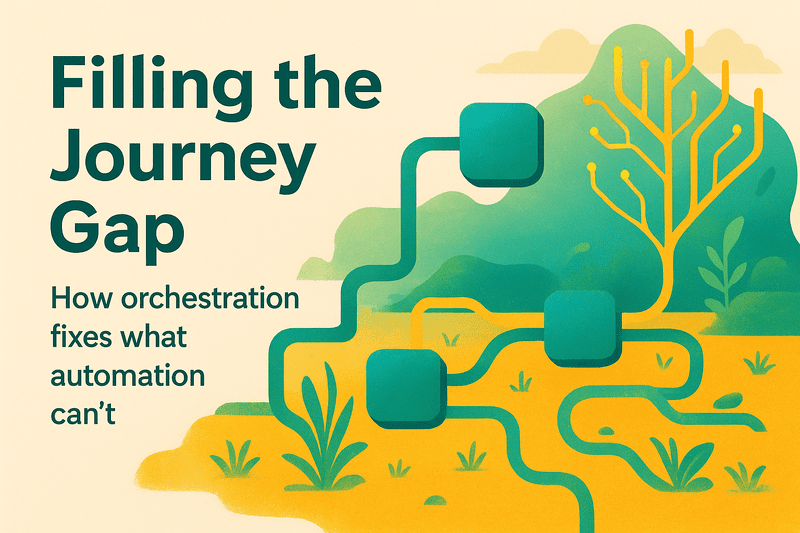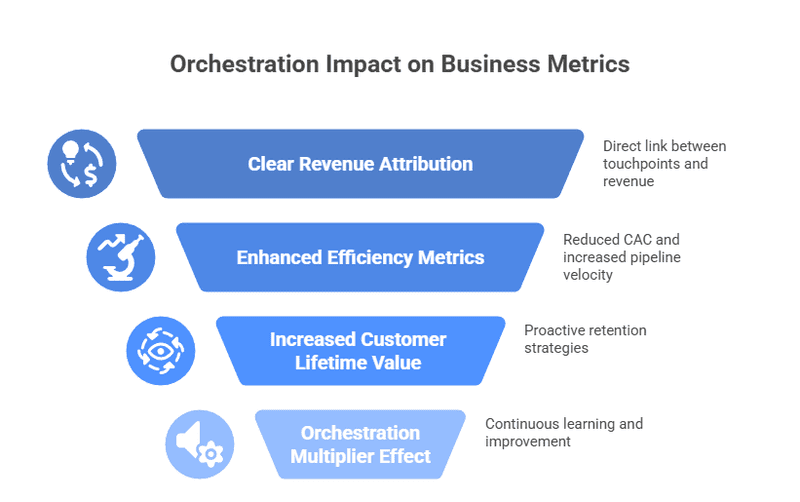Orchestration vs Automation: How Journey Orchestration Fills the Gap

Marketing has entered a new era where customer journeys are unpredictable, multi-device, and constantly shifting. The shift from basic campaign execution to intelligent, context-aware customer engagement requires moving beyond automation to journey orchestration.
While automation executes simple tasks, orchestration executes intelligent, real-time customer experiences that adapt to every customer signal.
Your prospect downloads a whitepaper at 2 AM, visits your pricing page twice the next morning, then abandons their cart that afternoon after a frustrating chatbot interaction. By the time your marketing automation system triggers the "abandoned cart" email three hours later, they've already signed with your competitor.
This isn't a failure of execution it's a failure of intelligence.
Traditional marketing automation was built for a world where customers followed predictable paths and patience was abundant. But today's buyers move fluidly across channels, expect instant relevance, and punish brands that treat them like anonymous workflow triggers.
The gap between what automation can do (execute pre-set tasks) and what customers demand (intelligent, context-aware experiences) has become a chasm that's costing you revenue every single day.
This article explores customer journey orchestration as the adaptive engine necessary for modern engagement, contrasting it with outdated automation methods that are reaching their functional ceiling.
Because the real question isn't whether your marketing executes. It's whether it thinks!
Definitions: Understanding The Orchestration Hierarchy
Automation is the use of technology to perform specific tasks or actions without manual intervention. It follows predefined rules or triggers to execute repetitive, predictable steps such as sending an email, updating a database record, or running a script making individual tasks faster, consistent, and more efficient.
Orchestration is the coordinated management of multiple automated tasks into a unified, end-to-end process. It manages dependencies, sequencing, real-time decisions, and data flow across systems. Orchestration ensures that many automated actions work together intelligently to achieve a complete workflow or outcome.
Where as Marketing Automation represents rule-based execution in a single tool that sends pre-defined messages when trigger conditions are met.
Think automated task firing: if X happens, send Y message. Journey Automation coordinates campaigns across multiple steps or channels but still relies on present paths with limited adaptation once launched.
Journey Orchestrationdelivers real-time decisioning that adapts paths across tools based on every new signal in the marketing memory bank. It coordinates the entire customer journey management experience using unified profiles and intelligent decision-making. Agentic AI Journey Orchestration represents the cutting edge autonomous agents that decide, test, and adjust customer journeys with policy guardrails and human oversight.
A marketing orchestration platform provides the infrastructure making this coordination possible, requiring integration across your entire martech stack.
Automation vs. Orchestration: The Critical Differences

Why Automation Fails in Today’s Non-Linear Customer Journeys
Traditional marketing automation systems are reaching their functional ceiling, struggling primarily because they lack the comprehensive view and real-time intelligence required for modern consumer expectations.
Static and Non-Adaptive
Automation relies on hard-coded rules and pre-set paths, making the resulting customer experience repetitive and campaign-centric. This linear approach means that once an automated customer journey is launched, its adaptation is limited. Customers receive the same messages regardless of changing circumstances, leading to irrelevant touchpoints and disengagement.
No Unified View (Information Silos)
Marketing automation tools often rely solely on channel-level identifiers, creating a fragmented view of the customer. Traditional automation lacks deep identity stitching, holistic measurement, and policy-aware decisioning. These information silos are highly problematic for marketing agility you can't deliver personalized experiences when you don't know that the email subscriber, website visitor, and app user are the same person.
Delayed Handoffs (The Pace Problem)
Traditional, rule-based systems struggle with the speed and autonomy necessary for contemporary experiences. They cannot react to qualitative changes such as a shift in a customer's mood or urgency in real time, leading to slow and inefficient service handoffs. By the time a hot lead gets routed to sales, they may have already moved on to a competitor.

How Journey Orchestration Fixes What Automation Breaks
Journey Orchestration replaces the rigid, rule-based approach of traditional marketing automation with a dynamic, context-aware real-time engine that adapts to customer behavior as it happens.
A. Unified View and Context-Awareness
Journey orchestration solves the "no unified view" problem by demanding a robust data foundation:
The Marketing Memory Bank: Orchestration relies on building a comprehensive "Marketing Memory Bank" by centralizing data and achieving the Single Customer View (SCV). This foundational data layer fuses identities, events, and qualitative signals across every touchpoint.
Powered by Integrated Data: The customer journey optimizer layer uses CRM and Customer Data Platform (CDP) data to build a unified customer understanding. It extracts qualitative signals like mood, intent, and urgency from unstructured dialogue through Conversation Analysis to fuel intelligent action. This means the system knows not just what a customer did, but why they did it and how they're feeling about it.
B. Solving the Slow Pipeline Problem
Orchestration's real-time intelligence layer ensures the system moves prospects through the lifecycle efficiently, driving benefits such as:
Faster pipeline velocity: The system can blend intent signals into a "hotness" score to rank and score prospects instantly
Lower Customer Acquisition Cost (CAC): By auto-queuing the hottest leads for outreach the moment readiness peaks, you reduce wasted effort
Stronger retention: Dynamic path branching based on intent or mood ensures customers always receive relevant, timely engagement
C. Agentic AI That Learns, Adapts, and Executes
Orchestration moves beyond sequential steps to create dynamic, intent-based actions. This intelligence layer is driven by Agentic AI:
Real-Time Adaptation: The system continuously learns from every interaction, using machine learning to refine its understanding of what works for each customer segment and individual.
Autonomous Action: An Agentic AI layer sits across the existing marketing stack, turning every customer interaction message, click, call into an instant, sentiment-aware action. These AI agents are goal-oriented, qualifying, nurturing, and selling 24/7 across any channel, thereby achieving true one-on-one orchestration at scale.
From Awareness to Advocacy: Journey orchestration handles the complete customer lifecycle. A prospect in the awareness stage might receive educational content timed to their research patterns. As they move to consideration, the system dynamically adjusts messaging based on which features they've explored. Post-purchase, it monitors usage patterns and satisfaction signals to prevent churn and identify expansion opportunities.
What Journey Orchestration Looks Like in Practice
Journey orchestration doesn't manage isolated campaigns—it conducts the entire customer lifecycle as a continuous, adaptive experience.
In the awareness stage, orchestration identifies anonymous visitors through behavioral signals and progressively builds their profile. When a prospect downloads content, the system analyzes content consumption patterns, time spent on pages, and research velocity to understand buying intent before they fill out forms.
As prospects move to consideration, the orchestration layer taps into CRM data to understand account context while CDP data reveals their digital body language. If a prospect explores enterprise pricing but behavioral signals suggest budget concerns, orchestration dynamically adjusts messaging to emphasize ROI and payment flexibility rather than pushing for immediate demos.
During evaluation, the system monitors engagement intensity. If a hot prospect suddenly goes quiet after a proposal, orchestration doesn't wait for sales reps to notice—it triggers personalized re-engagement based on competitive intelligence or automatically surfaces relevant case studies from similar companies.
Post-purchase, orchestration shifts from acquisition to retention and expansion. It monitors product usage patterns, support ticket sentiment, and health scores to intervene before churn risk materializes. When usage data suggests readiness for upsell, orchestration coordinates perfectly-timed outreach that feels helpful, not salesy.
The KPI Shift: How Orchestration Impacts Revenue, Lift, and Customer Lifetime Value
The shift to journey orchestration fundamentally changes what success looks like.
Journey-Level KPIs Replace Channel Metrics: Instead of tracking whether someone opened an email, you track time-to-value how quickly prospects move from first touch to closed deal. Instead of counting website visits, you measure incremental lift the quantifiable revenue impact of orchestrated experiences versus static campaigns.
Revenue Attribution Becomes Crystal Clear: Because orchestration unifies data across the entire customer journey, you get clear line-of-sight from touchpoints to revenue. Multi-touch attribution stops being theoretical and becomes operational reality.
Efficiency Metrics Show True Scale: CAC drops because orchestration eliminates wasted effort. Pipeline velocity accelerates because the system routes the right leads at the right moment. Customer Lifetime Value increases because retention becomes proactive rather than reactive.
The Orchestration Multiplier: True orchestration creates a compounding effect automation can never achieve. Each interaction feeds the intelligence layer, making every subsequent decision smarter. A customer's support ticket sentiment informs their renewal campaign. Product usage patterns trigger perfectly-timed expansion conversations. Engagement signals automatically adjust lead scores, ensuring sales always works the hottest opportunities first.

Orchestration boosts revenue, efficiency, retention, and continuous improvement.
Zigment: The Future of Intelligent Orchestration
Zigment transcends the limits of traditional automation by integrating three capabilities automation cannot offer: a Unified Data Layer (Marketing Memory Bank) that creates the Single Customer View across all touchpoints, Real-Time Intent Intelligence powered by Conversation Graph and fuzzy signal extraction that understands customer mood and urgency as they happen, and an Autonomous Execution Engine with Agentic AI workflows that acts on insights instantly without human intervention.
It orchestrates journeys, not just automates tasks. Where automation sends messages, Zigment guides experiences. Where automation reacts slowly, Zigment adapts instantly based on real-time behavioural signals and qualitative context.
Where automation treats everyone the same with preset workflows, Zigment personalizes every step using continuous intelligence from CRM and CDP data flowing through the orchestration layer.
This is the true promise of Journey Orchestration context-aware, adaptive, intelligent customer engagement that drives measurable revenue impact and Zigment is purpose-built to deliver it. The future of marketing isn't automation. It's intelligent orchestration that thinks, learns, and acts in real time.